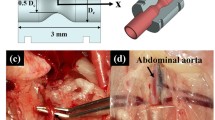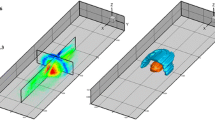Abstract
The evaluation of strain induced in a blood vessel owing to contact with a medical device is of significance to examine the causes leading to vascular injury and rupture. The development of a method to assess strain in largely deformed elastic materials is expected. This study’s scope was to measure strain in deformed tubular elastic mock vessels using tomographic particle image velocimetry (tomo-PIV), and to show the applicability of this measurement method by comparing the results with data derived from a finite element analysis (FEA). Strain distribution was calculated from the displacement distribution, which in turn was measured by tracking fluorescent 13 μm particles in a transparent tubular elastic model using tomo-PIV. The von Mises strain distribution was calculated for a model whose inner diameter was subjected to a pressure load, because of which it expanded from 25 to 27.5 mm, adjusting to the diameter change of a human aorta during heartbeat. An FEA simulating the experiment was also conducted. Three-dimensional strain was successfully measured by using the tomo-PIV method. The radial strain distribution in the model linearly decreased outward (from the its inner to its outer side), and the result was consistent with the data obtained from the FEA. The mean von Mises strain measured using tomo-PIV was comparable with that obtained from the FEA (tomo-PIV: 0.155, FEA: 0.156). This study demonstrates the feasibility of utilizing tomo-PIV to quantitatively assess the three-dimensional strain induced in largely deformed elastic models.






Similar content being viewed by others
References
Altngi, H. E., B. Bousaid, and H. W. Berre. Morphological and stent design risk factors to prevent migration phenomena for a thoracic aneurysm: a numerical analysis. Med. Eng. Phys. 37:23–33, 2015.
Auricchio, F., M. Conti, M. D. Beule, G. D. Santis, and B. Verhegghe. Carotid artery stenting simulation: from patient-specific images to finite element analysis. Med. Eng. Phys. 33:281–289, 2011.
Auricchio, F., M. Conti, S. Morganti, and A. Reali. Simulation of transcatheter aortic valve implantation: a patient-specific finite element approach. Comput. Methods Biomech. Biomed. Eng. 17(12):1–11, 2014.
Bazilevs, Y., M. C. Hsu, Y. Zhang, W. Wang, T. Kvamsdal, S. Hentschel, and J. G. Isaksen. Computational vascular fluid–structure interaction: methodology and application to cerebral aneurysms. Biomech. Model Mechanobiol. 9:481–498, 2010.
Benbarek, S., B. Bouiadjra, B. T. Achour, and B. Serier. Finite element analysis of the behavior of crack emanating from microvoid in cement of reconstructed acetabulum. Mat. Sci. Eng. A-Struct. 457:385–391, 2007.
Benoit, A., S. Guerard, B. Gillet, G. Guillot, F. Hild, D. Mitton, J. N. Peire, and S. Roux. 3D analysis from micro-MRI during in situ compression on cancellous bone. J. Biomech. 42:2381–2386, 2009.
Birjinjuk, J., J. M. Ruddy, E. Iffrig, T. S. Henry, B. G. Leshnower, J. N. Oshinski, D. N. Ku, and R. K. Veeraswamy. Development and testing of a silicone in vitro model of descending aortic dissection. J. Surg. Res. 198:502–507, 2015.
Buchmann, N. A., C. Atkinson, M. C. Jeremy, and J. Soria. Tomographic particle image velocimetry investigation of the flow in a modeled human carotid artery bifurcation. Exp. Fluids 50(4):1131–1151, 2011.
Burton, A. C. Relation of structure to function of the tissues of the wall of blood vessels. Physiol. Rev. 34:619–642, 1954.
Cheng, Y. Y., J. Y. Li, S. L. Fok, W. L. Cheung, and T. W. Chow. 3D FEA of high-performance polyethylene fiber reinforced maxillary dentures. Dent. Mater. 26:e211–e219, 2010.
Ducci, A., F. Pirisi, S. Tzamtzis, and G. Burriesci. Transcatheter aortic valves produce unphysiological flows which may contribute to thromboembolic events: an in vitro study. J. Biomech. 49:4080–4089, 2016.
Elsinga, G. E., F. Scarano, B. Wieneke, and B. W. V. Oudheusden. Tomographic particle image velocimetry. Exp. Fluids 41(6):933–947, 2006.
Elsinga, G. E., and S. Togoz. Ghost hunting: an assessment of ghost particle detection and removal methods for tomo-PIV. Meas. Sci. Technol. 25:084004, 2014.
Gahagnon, S., Y. Mofid, G. Josse, and F. Ossant. Skin anisotropy in vivo and initial natural stress effect: a quantitative study using high-frequency static elastography. J. Biomech. 45:2860–2865, 2012.
Germaneau, A., P. Doumalin, and J. C. Dupre. 3D strain field measurement by correlation of volume images using scattered light: recording of images and choice of marks. Strain 43(3):207–218, 2007.
Gillard, F., R. Boardman, M. Mavrogordato, D. Hollis, I. Sinclair, F. Pierron, and M. Browne. The application of digital volume correlation (DVC) to study the microstructural behaviour of trabecular bone during compression. J. Mech. Behav. Biomed. Mater. 29:480–499, 2014.
Gutowski, V., L. Russell, and A. Cerra. New tests for adhesion of silicone sealants. Constr. Build. Mater. 7(1):19–25, 1993.
Hasler, D., A. Landolt, and D. Obrist. Tomographic PIV behind a prosthetic heart valve. Exp. Fluids 57:80, 2016.
Herman, G. T., and A. Lent. Iterative reconstruction algorithms. Comput. Biol. Med. 6:273–294, 1976.
Hussein, A. I., P. E. Barbone, and E. F. Morgan. Digital volume correlation for study of the mechanics of whole bones. Procedia IUTAM. 4:116–125, 2012.
Itoh, H., and Y. Yamada. Measurement of silicone rubber using impedance change of a quartz-crystal tuning-fork tactile sensor. J. Appl. Phys. 45:4643–4646, 2006.
Kono, K., and T. Terada. In vitro experiments of vessel wall apposition between the enterprise and enterprise 2 stents for treatment of cerebral aneurysms. Acta Neurochir. 158:241–245, 2016.
Liang, D. K., D. Z. Yang, M. Qi, and W. Q. Wang. Finite element analysis of the implantation of a balloon-expandable stent in a stenosed artery. Int. J. Cardiol. 104:314–318, 2005.
Madi, K., G. Tozzi, Q. H. Zhang, J. Tong, A. Cossey, A. Au, D. Hollis, and F. Hild. Computation of full-field displacements in a scaffold implant using digital volume correlation and finite element analysis. Med. Eng. Phys. 35:1298–1312, 2013.
Maier, A., M. W. Gee, C. Reeps, J. Pongratz, H. H. Eckstein, and W. A. Wall. A comparison of diameter, wall stress, and rupture potential index for abdominal aortic aneurysm rupture risk prediction. Ann. Biomed. Eng. 38(10):3124–3134, 2010.
Martin, D., and F. Boyle. Finite element analysis of balloon-expandable coronary stent deployment: influence of angioplasty balloon configuration. Int. J. Numer. Method Biomed. Eng. 29:1161–1175, 2013.
Mucke, T., L. M. Ritschl, A. B. Dipl, K. D. Wolff, D. A. Mitchell, and D. Liepsch. Opened end-to-side technique for end-to-side anastomosis and analyses by an elastic true-to-scale silicone rubber model. Microsurgery 34(1):28–36, 2013.
Nikanorov, A., H. B. Smouse, K. Osman, M. Bialas, S. Shrivastava, and L. B. Schwartz. Fracture of self-expanding nitinol stents stressed in vitro under simulated intravascular conditions. J. Vasc. Surg. 48(2):435–440, 2008.
Novara, M., K. J. Batenburg, and F. Scarano. Motion tracking enhanced MART for tomo-PIV. Meas. Sci. Technol. 21:035401, 2010.
Novara, M., and F. Scarano. Performances of motion tracking enhanced tomo-PIV on turbulent shear flows. Exp. Fluids 52:1027–1041, 2012.
Pericevic, I., L. Caitriona, D. Toner, and D. J. Kelly. The influence of plaque composition on underlying arterial wall stress during stent expansion: the case for lesion-specific stents. Med. Eng. Phys. 31:428–433, 2009.
Roberts, B. C., E. Perilli, and K. J. Reynolds. Application of the digital volume correlation technique for the measurement of displacement and strain fields in bone: a literature review. J. Biomech. 47:923–934, 2014.
Scarano, F. Tomo-PIV: principles and practice. Meas. Sci. Technol. 24:012001, 2013.
Scarano, F., and M. Riethmuller. Advances in iterative multigrid PIV image processing. Exp. Fluids 29(7):51–60, 2000.
Tanaka, Y., S. Saito, S. Sasuga, A. Takahashi, Y. Aoyama, K. Obama, M. Umezu, and K. Iwasaki. Quantitative assessment of paravalvular leakage after transcatheter aortic valve replacement using a patient-specific pulsatile flow model. Int. J. Cardiol. 258:313–320, 2018.
Verhulp, E., B. V. Rietbergen, and R. Huiskes. A three-dimensional digital image correlation technique for strain measurements in microstructures. J. Biomech. 37:1313–1320, 2004.
Wang, Y., Y. Hu, X. Gong, W. Jiang, P. Zhang, and Z. Chen. Preparation and properties of magnetorheological elastomers based on silicone rubber/polystyrene blend matrix. J. Appl. Polym. Sci. 103:3143–3149, 2007.
Wang, Q., S. Kodali, C. Primiano, and W. Sun. Simulations of transcatheter aortic valve implantation: implications for aortic root rupture. Biomech. Model Mechanobiol. 14(1):29–38, 2015.
Wells, P. N. T., and H. D. Liang. Medical ultrasound: imaging of soft tissue strain and elasticity. J. R. Soc. Interface 8:1521–1549, 2011.
Wernet, M. P., and J. A. Hadley. A high temperature seeding technique for particle image velocimetry. Meas. Sci. Technol. 27:125201, 2016.
Wieneke, B. Volume self-calibration for 3D particle image velocimetry. Exp. Fluids 45:549–556, 2008.
Acknowledgments
This research was partially supported by the Research on Regulatory Science of Pharmaceuticals and Medical Devices from the Japan Agency for Medical Research and Development, AMED (No. 17mk0102042h0003) and the Japan Society for Promotion of Science (15J07145).
Conflict of interest
All authors declare that they have no conflicts of interest.
Ethical Approval
This article does not contain any studies with human participants performed by any of the authors.
Author information
Authors and Affiliations
Corresponding author
Additional information
Associate Editors Ulrich Steinseifer and Ajit P. Yoganathan oversaw the review of this article.
Rights and permissions
About this article
Cite this article
Takahashi, A., Zhu, X., Aoyama, Y. et al. Three-Dimensional Strain Measurements of a Tubular Elastic Model Using Tomographic Particle Image Velocimetry. Cardiovasc Eng Tech 9, 395–404 (2018). https://doi.org/10.1007/s13239-018-0350-5
Received:
Accepted:
Published:
Issue Date:
DOI: https://doi.org/10.1007/s13239-018-0350-5




